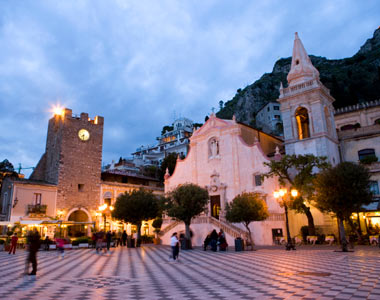Lovely touristy town on the eastern side of Etna, can be reached from Siracusa with an hour drive or by train (1 hour and 50 minutes). It can also be reached by bus, but you have to change in Catania. Destination of a flow of millions of tourists, perched on a hill overlooking the coast, from Taormina you can enjoy a breathtaking view. The most visited part of the historic center is constituted by a main road which it is lined with shops, restaurants and bars. The Ancient Theatre is the main monument of the town, not only for its artistic value, but also for the incredible location. The view enjoyed from up there is even called the 'scene par excellence', not to be missed.
It is the second oldest theater on the island (diameter m 109) after that of Syracuse and was built in the Hellenistic period (I - II century BC). Modified and extended about 300 years later, it was used by Romans for the fights of the gladiators. The theatre, whose acoustics are great, is also used for musical and theatrical performances in summer. The Naumachia, along with the theater, is the second largest remain of the Roman city and also one of the greatest Roman monuments of the island. This is a large terrace that protected a now non-existent tank. It seems that naval battles were held there, hence the name. In Palazzo Corvaja, built on a earlier 15th century structure, was established in 1410 the Sicilian Parliament. On the facade develops a band on which were written in Latin a series of moral judgments. Higher up, on the first floor, large open windows are located, while the courtyard is quite picturesque. The Cathedral, dedicated to St. Nicholas, was built in the thirteenth century. Later, in the fifteenth, sixteenth and seventeenth centuries it was remodeled. The main portal, surmounted by a small rose window and flanked by two windows, dates from 1636 and is in Renaissance style; other two portals, the fifteenth and sixteenth, respectively, are opened on the left and right side (considerable, in particular, the first). Inside, in the three aisles, there are interesting paintings by Antonino Giuffre (1436) and a polyptych by Antonello de Saliba (1504).
The elegant Palace of the Dukes of Santo Stefano, built between the fourteenth and fifteenth century, is a fine example of Sicilian architecture. The mighty external walls are lightened by mullioned windows, four down and four more elegant on the main floor. Going further up the hill to Taormina you can visit the lovely small town of Castelmola, with its narrow streets and bars. Down the hill of Taormina is located the seaside resort of Giardini Naxos, reachable by bus or cable car, with a long pebble beach and a promenade full of bars and restaurants.

